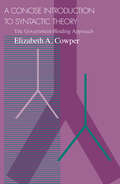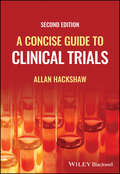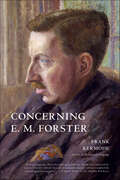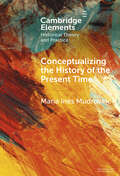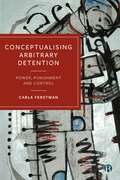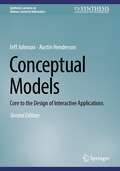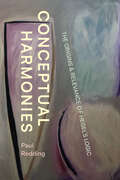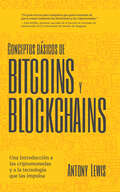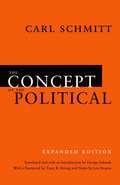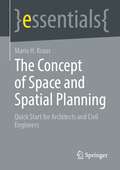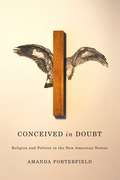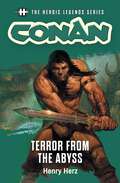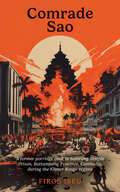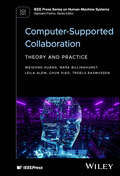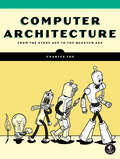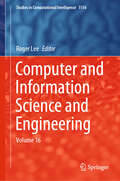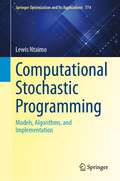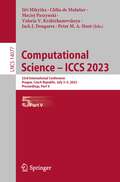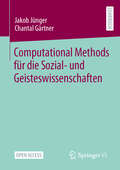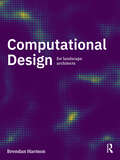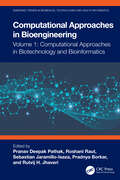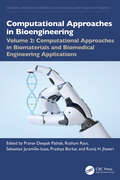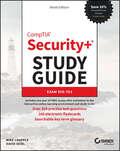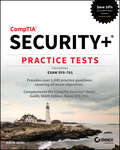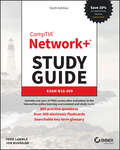- Table View
- List View
A Concise Introduction to Syntactic Theory: The Government-Binding Approach
by Elizabeth A. CowperThis textbook is intended to give students a quick start in using theory to address syntactic questions. At each stage, Cowper is careful to introduce a theoretical apparatus that is no more complex than is required to deal with the phenomenon under consideration. Comprehensive and up-to-date, this accessible volume will also provide an excellent refresher for linguists returning to the study of Government-Binding theory. "Cowper exhibits the analytical devices of current principles-and-parameters approaches, takes readers carefully through the central elements of grammatical theory (including very recent work), and ushers them selectively into the technical literature. . . . A serious introduction for those who want to know the nuts and bolts of syntactic theory and to see why linguists are so excited these days."—David Lightfoot, University of Maryland "An excellent short introduction to the Government and Binding model of syntactic theory. . . . Cowper's work succeeds in teaching syntactic argumentation and in showing the conceptual reasons behind specific proposals in modern syntactic theory."—Jaklin Kornfilt, Syracuse University
A Concise Guide to Clinical Trials
by Allan HackshawDesign and execute life-saving trials with this accessible resource Clinical trials have revolutionized the treatment of disease and the development of life-saving pharmaceuticals. They contribute decisively to diagnosis, the avoidance of early death, medical intervention and are central to the modern work of pharmaceutical producers. The design and execution of clinical trials is one of the fastest-growing and most important areas of medical and pharmaceutical research. A Concise Guide to Clinical Trials provides an accessible and comprehensive survey of clinical trials, their design, and their applications. Beginning with a taxonomy of trial types, the book overviews stages of analysis, ethical and legal requirements, and more. Now fully updated to reflect the latest research and clinical practice, it continues to be an indispensable resource for researchers and clinicians. Readers of the second edition of A Concise Guide to Clinical Trials will also find: New material on pharmaceutical trials, adaptive designs, and the use of “big data” The easy-to-use organization facilitates both first-time learning and reference Detailed treatment of concepts such as health technology assessments (HTA), patient and public involvement and engagement (PPIE), and more A Concise Guide to Clinical Trials is ideal for clinicians and healthcare professionals looking for a working knowledge of clinical trials, as well as for pharmaceutical workers and regulators looking to understand this vital aspect of the industry.
Concerning E. M. Forster
by Frank KermodeA major reassessment of the great English novelistThis impressive new book by the celebrated British critic Frank Kermode examines hitherto neglected aspects of the novelist E. M. Forster's life and work. Kermode is interested to see how it was that this apparently shy, reclusive man should have claimed and kept such a central position in the English writing of his time, even though for decades he composed no fiction and he was not close to any of his great contemporaries—Henry James, Ford Madox Ford, Joseph Conrad, James Joyce.Concerning E. M. Forster has at its core the Clark Lectures that Kermode gave at Cambridge University in 2007 on the subject of Forster, eighty years after Forster himself gave those lectures, which became Aspects of the Novel. Kermode reappraised the influence and meaning of that great work, assessed the significance of Forster's profound musicality (Britten thought him the most musical of all writers), and offered a brilliant interpretation of Forster's greatest work, A Passage to India. But there is more to Concerning E. M. Forster than that. Thinking about Forster vis-àvis other great modern writers, noting his interest in Proust and Gide and his lack of curiosity about American fiction, and observing that Forster was closest to the people who shared not his literary interests or artistic vocation but, rather, his homosexuality, Kermode's book offers a wise, original, and persuasive new portrait not just of Forster but of twentieth-century English letters.
Conceptualizing the History of the Present Time (Elements in Historical Theory and Practice)
by null María Inés MudrovcicIn this work, I explore four meanings of 'contemporary,' emphasizing its designation as a historical field. I argue that disagreements about when the presento or the contemporary era begins stem from historians assuming a linear, chronological, and absolute conception of time. Following scholars like L. Descombes, L. Hölscher, B. Latour, D. J. Wilcox and S. Tanaka, I propose conceiving relational historical time without chronology, emphasizing the original sense of “sharing the same time” that 'contemporary' acquired for the first time. This perspective mitigates issues concerning the 'beginnings' or 'meaning' of the present. Emphasizing relationships within a relational time framework aids in overcoming ontological challenges like 'so many presents' or 'distance in time,' along with the corresponding epistemological issue of 'objectivity.' This exploration aims to reevaluate and enrich our understanding of the multifaceted concept of the 'present' in the context of history.
Conceptualising Arbitrary Detention: Power, Punishment and Control
by Carla FerstmanAvailable open access digitally under CC-BY-NC-ND licence This book examines what happens when states and other authorities use detention to abuse their power, deter dissent and maintain social hierarchies. Written by an author with decades of practical experience in the human rights field, the book examines a variety of scenarios where individuals are unlawfully detained in violation of their most basic rights to personal liberty and exposes the many fallacies associated with arbitrary detention. Proposing solutions for future policy to scrutinise processes, this is a call for greater respect for the rule of law and human rights.
Conceptual Models: Core to the Design of Interactive Applications (Synthesis Lectures on Human-Centered Informatics)
by Jeff Johnson Austin HendersonThis book presents readers with an exploration of the concept of Conceptual Models and argues that they are core to achieving good design of interactive applications that are easy, effective, and enjoyable to use. The authors’ years of experience helping companies create interactive software applications revealed that interactive applications built without Conceptual Models generally result in fraught production processes and designs that are confusing and difficult to learn, remember, and use. Instead, the book shows that Conceptual Models can be a central link between the elements involved in the use of interactive applications: people’s tasks (domains), their plans for performing those tasks, the use of applications in the plans, the conceptual structure of applications, the presentation of the conceptual model (i.e., the user interface), the terms used to describe it, its implementation, and the learning that people must do to use the application. Readers will learn how putting a Conceptual Model at the core of the design and development process can pay rich dividends: designs are simpler, more coherent, and better aligned with users’ tasks; unnecessary features are avoided; documentation is easier, development is faster and cheaper; customer uptake is improved; and the need for training and customer support is reduced. To support its use in instruction, this second edition has been revised to explain the history and theoretical context of conceptual modeling using a consistent vocabulary, describe the structure of conceptual models, provide more current and more complete examples, explain how conceptual models fit into design and development, and further summarize the benefits of conceptual modeling.
Conceptual Harmonies: The Origins and Relevance of Hegel’s Logic
by Paul ReddingA new reading of Hegel’s Science of Logic through the history of European mathematics.Conceptual Harmonies develops an original account of G. W. F. Hegel’s perplexing Science of Logic from a simple insight: philosophical and mathematical thought have shaped each other since classical times. Situating Science of Logic within the rise of modern mathematics, Redding stresses Hegel’s attention to Pythagorean ratios, Platonic reason, and Aristotle’s geometrically inspired logic. He then explores how later traditions shaped Hegel’s world, through both Leibniz and new forms of algebraic geometry. This enlightening reading recovers an overlooked stream in Hegel’s philosophy that remains, Redding argues, important for contemporary conceptions of logic.
Conceptos básicos de Bitcoins y Blockchains: Una Introducción a las criptomonedas y a la tecnología que las impulsa
by Antony LewisAprende sobre invertir en Bitcoin, blockchains, y criptomonedas“Antony nos ayuda a entender claramente los mecanismos de bitcoins y blockchains.” —Rob Findlay, fundador de Next MoneyEl autor más vendido en inversión de derivados financieros, industria extractiva de recursos naturales, futuros, bancos y bancas, energía y minas, y política monetaria.Hay mucha información sobre criptomonedas y blockchains, pero para un principiante, esto puede ser indescifrable. Conceptos básicos sobre bitcoins y blockchains ofrece una guía clara sobre carteras digitales, esta nueva moneda y la tecnología revolucionaria que la impulsa.Bitcoin, Ethereum, Altcoin, criptografía y otras criptomonedas. Gana entendimiento de temas relacionados a Bitcoin, precio Bitcoin, moneda Bitcoin, minería Bitcoin, invertir en Bitcoin y los Bitcoins blockchains. Aprende cómo se realizan los pagos y cómo establecer el valor de las criptomonedas y de los tokens digitales.Aprende qué es blockchain. ¿Cómo funciona? ¿Y por qué es importante? Conceptos básicos sobre bitcoins y blockchains da respuestas a estas preguntas y más.Aprende sobre minería de criptomonedas y criptomonedas.Conceptos básicos sobre bitcoin y blockchains ofrece una perspectiva confiable de cómo invertir en Bitcoin y otras criptomonedas. Descubre los riesgos y las estrategias de mitigación, aprende cómo comprar Bitcoins, identificar estafas, y entender el cambio de criptomonedas, billeteras digitales, y regulaciones.Aprende sobre:Tecnología blockchain y a invertir en Bitcoin.Cómo trabajar en el mercado de las criptomonedas.La evolución y los impactos potenciales del Bitcoin y los blockchains a nivel mundial.Si has leído Descubre Blockchain, Blockchain Bubble or Revolution, Bitcoin Clarity, The Bitcoin Book, y Bitcoin and Cryptocurrency Trading for Beginners, entonces vas a aprender mucho con Conceptos básicos sobre bitcoins y blockchains.
The Concept of the Political: Expanded Edition (None Ser.)
by Carl SchmittIn this, his most influential work, legal theorist and political philosopher Carl Schmitt argues that liberalism’s basis in individual rights cannot provide a reasonable justification for sacrificing oneself for the state—a critique as cogent today as when it first appeared. George Schwab’s introduction to his translation of the 1932 German edition highlights Schmitt’s intellectual journey through the turbulent period of German history leading to the Hitlerian one-party state. In addition to analysis by Leo Strauss and a foreword by Tracy B. Strong placing Schmitt’s work into contemporary context, this expanded edition also includes a translation of Schmitt’s 1929 lecture “The Age of Neutralizations and Depoliticizations,” which the author himself added to the 1932 edition of the book. An essential update on a modern classic, The Concept of the Political, Expanded Edition belongs on the bookshelf of anyone interested in political theory or philosophy.
The Concept of Space and Spatial Planning: Quick Start for Architects and Civil Engineers (essentials)
by Mario H. KrausSpace is an ambiguous and sometimes controversial term. Spatial planning is based on a delicate and changeable social balance, which is reflected in the legal basis (with German law code as example) and everyday implementation. In this essential, approaches from phenomenology are used to classify the various concepts of space.
Conceived in Doubt: Religion and Politics in the New American Nation (American Beginnings, 1500-1900 Ser.)
by Amanda PorterfieldAmericans have long acknowledged a deep connection between evangelical religion and democracy in the early days of the republic. This is a widely accepted narrative that is maintained as a matter of fact and tradition—and in spite of evangelicalism’s more authoritarian and reactionary aspects.In Conceived in Doubt, Amanda Porterfield challenges this standard interpretation of evangelicalism’s relation to democracy and describes the intertwined relationship between religion and partisan politics that emerged in the formative era of the early republic. In the 1790s, religious doubt became common in the young republic as the culture shifted from mere skepticism toward darker expressions of suspicion and fear. But by the end of that decade, Porterfield shows, economic instability, disruption of traditional forms of community, rampant ambition, and greed for land worked to undermine heady optimism about American political and religious independence. Evangelicals managed and manipulated doubt, reaching out to disenfranchised citizens as well as to those seeking political influence, blaming religious skeptics for immorality and social distress, and demanding affirmation of biblical authority as the foundation of the new American national identity.As the fledgling nation took shape, evangelicals organized aggressively, exploiting the fissures of partisan politics by offering a coherent hierarchy in which God was king and governance righteous. By laying out this narrative, Porterfield demolishes the idea that evangelical growth in the early republic was the cheerful product of enthusiasm for democracy, and she creates for us a very different narrative of influence and ideals in the young republic.
Conan: The Heroic Legends Series (The Heroic Legends Series #9)
by Henry HerzCapturing the electric short fiction energy that led Robert E. Howard to be one of the top fantasy writers of the century, with exclusive serialized eBook stories starring Conan, Solomon Kane, and more by many of today&’s top writers in fantasy and sword-and-sorcery.Sailing together on the Tigress, Conan and Bêlit hijack and plunder a ship. Victorious but with a damaged ship to show for it, the pirates return to their secret island haven. They arrive to find their village under attack, not by men, but hideous things—part men, part aquatic creatures.Powerful but ungainly, these bloodthirsty frog-men are faster and even more formidable in the water. Conan, Bêlit and her crew watch helplessly as the abominations abscond with the women of their village. Unable to give chase due to their damaged ship, Conan and Bêlit swear vengeance on these monstrosities.
Comrade Sao: A Former Porridge Cook of Samrong Temple Prison, Battambang Province, Cambodia, during the Khmer Rouge Regime
by Firos Iseu‘Thursday 17 April 1975 is the day that I will never forget until the day I die. That was the day the Khmer Rouge took over Phnom Penh and overthrew the government of General Lon Nol and his Republican Party…’ Thus begins Firos Iseu’s gripping memoir of his experiences during the Khmer Rouge’s brutal regime in Cambodia between April 1975 and January 1979. At the tender age of 12, Iseu – whose ‘revolutionary name’, Comrade Sao, provides the book with its title – faced the horrors of the regime’s first wave of killings, which at a stroke deprived him of his parents and elder siblings. Bearing a diverse heritage of Indian, Laotian, and Vietnamese roots, he was branded a ‘17 April’ or ‘new’ person, marking him as an outsider and second-class citizen. Comrade Sao stands as a testament to the resilience of the human spirit, showcasing the author’s remarkable courage and resourcefulness in the face of terrifying adversity. This harrowing, unflinching and above all honest narrative sheds a necessary light on one of the darkest chapters of humanity of the past 50 years.
Computer-Supported Collaboration: Theory and Practice (IEEE Press Series on Human-Machine Systems)
by Weidong Huang Leila Alem Mark Billinghurst Chun Xiao Troels RasmussenDiscover the latest developments in AR, VR, mobile, and wearable technologies for the remote guidance of physical tasks In Computer-Supported Collaboration: Theory and Practice, an expert team of researchers delivers the latest instruction in using augmented reality (AR), virtual reality (VR), and mobile or wearable technology to support remote guidance on physical tasks. The authors offer an overview of the field before moving on to discuss state-of-the-art research developments in everything from shared visual spaces to the use of hand gestures and gaze information for better collaboration. The book also describes the hardware devices, software tools, and libraries that can be used to help build remote guidance systems, as well as the industrial systems and applications that have been used in real world settings. Finally, Computer-Supported Collaboration includes a discussion of the current challenges faced by practitioners in the field and likely future directions for new research and development. Readers will also discover: A thorough introduction and review of the art of remote guidance research and engineering Comprehensive explorations of the shared visual space used to support common grounding and the remote guidance of physical tasks, as well as mobility support for local workers Practical discussions of mobility support of workers and helpers in remote guidance, including systems that support hands-free interaction In-depth explorations of communication cues in remote guidance, including systems that support gesturing and sketching on a touch-based display Perfect for researchers and professionals working in human-computer interaction or computer-supported collaborative work, Computer-Supported Collaboration: Theory and Practice is also an ideal resource for educators and graduate students teaching or studying in these fields.
Computer Architecture
by Charles FoxNot since the 1980s has computer architecture been so exciting! This book captures the moment, mining the history of computing to teach key concepts in modern hardware design and introduce the neural and quantum architectures of the future.Computer Architecture is an in-depth exploration of the principles and designs that have shaped computer hardware through the ages, from counting devices like the abacus, to Babbage&’s Difference Engine, to modern GPUs and the frontiers of quantum computing.This engaging blend of history, theory, hands-on exercises, and real-world examples is sure to make for an insightful romp through a fast-changing world. You won&’t just read about computer architecture, you&’ll also gain the understanding to touch, build, and program it. You&’ll explore the basic structures of a CPU by learning to program a Victorian Analytical Engine. You&’ll extend electronic machines to 8-bit and 16-bit retro gaming computers, learning to program a Commodore 64 and an Amiga. You&’ll delve into x86 and RISC-V architectures, cloud and supercomputers, and ideas for future technologies. You&’ll also learn:• How to represent data with different coding schemes and build digital logic gates • The basics of machine and assembly language programming• How pipelining, out-of-order execution, and parallelism work, in context• The power and promise of neural networks, DNA, photonics, and quantum computing Whether you&’re a student, a professional, or simply a tech enthusiast, after reading this book, you&’ll grasp the milestones of computer architecture and be able to engage directly with the technology that defines today&’s world. Prepare to be inspired, challenged, and above all, see and experience the digital world, hands-on.
Computer and Information Science and Engineering: Volume 16 (Studies in Computational Intelligence #1156)
by Roger LeeThis book reports state-of-the-art results in Computer Information Science and Engineering in both printed and electronic form. Studies in Computation Intelligence (SCI) has grown into the most comprehensive computational intelligence research forum available in the world.
Computational Stochastic Programming: Models, Algorithms, and Implementation (Springer Optimization and Its Applications #774)
by Lewis NtaimoThis book provides a foundation in stochastic, linear, and mixed-integer programming algorithms with a focus on practical computer algorithm implementation. The purpose of this book is to provide a foundational and thorough treatment of the subject with a focus on models and algorithms and their computer implementation. The book’s most important features include a focus on both risk-neutral and risk-averse models, a variety of real-life example applications of stochastic programming, decomposition algorithms, detailed illustrative numerical examples of the models and algorithms, and an emphasis on computational experimentation. With a focus on both theory and implementation of the models and algorithms for solving practical optimization problems, this monograph is suitable for readers with fundamental knowledge of linear programming, elementary analysis, probability and statistics, and some computer programming background. Several examples of stochastic programming applications areincluded, providing numerical examples to illustrate the models and algorithms for both stochastic linear and mixed-integer programming, and showing the reader how to implement the models and algorithms using computer software.
Computational Science – ICCS 2023: 23rd International Conference, Prague, Czech Republic, July 3–5, 2023, Proceedings, Part V (Lecture Notes in Computer Science #10477)
by Jiří Mikyška Clélia De Mulatier Maciej Paszynski Valeria V. Krzhizhanovskaya Jack J. Dongarra Peter M. A. SlootThe five-volume set LNCS 14073-14077 constitutes the proceedings of the 23rd International Conference on Computational Science, ICCS 2023, held in Prague, Czech Republic, during July 3-5, 2023. The total of 188 full papers and 94 short papers presented in this book set were carefully reviewed and selected from 530 submissions. 54 full and 37 short papers were accepted to the main track; 134 full and 57 short papers were accepted to the workshops/thematic tracks. The theme for 2023, "Computation at the Cutting Edge of Science", highlights the role of Computational Science in assisting multidisciplinary research. This conference was a unique event focusing on recent developments in scalable scientific algorithms, advanced software tools; computational grids; advanced numerical methods; and novel application areas. These innovative novel models, algorithms, and tools drive new science through efficient application in physical systems, computational and systems biology, environmental systems, finance, and others.
Computational Methods für die Sozial- und Geisteswissenschaften
by Jakob Jünger Chantal GärtnerMit Computational Methods lassen sich digitale Welten wissenschaftlich erforschen und gestalten. Das Open-Access-Lehrbuch vermittelt zunächst grundlegende Kompetenzen für die automatisierte Erhebung und Aufbereitung von Daten und für den Umgang mit Datenbanken. Eine Einführung in die Programmiersprachen R und Python sowie in Versionsverwaltungen und Cloud-Computing eröffnet Wege für kreative Analyseansätze beim Umgang mit großen und kleinen Datensätzen. Schließlich werden Szenarien in sozial- und geisteswissenschaftlichen Anwendungsfeldern durchgespielt. Dazu zählen die automatisierte Datenerhebung über Programmierschnittstellen und Webscraping, automatisierte Textanalysen, Netzwerkanalysen, maschinelles Lernen und Simulationsverfahren. Neben einer konzeptionellen Einführung in die jeweiligen Themenfelder geht es vor allem darum, in kurzen Tutorials selbst erste praktische Erfahrungen zu sammeln sowie weiterführende Möglichkeiten, aber auch Limitationen, von Computational Methods kennenzulernen.
Computational Design for Landscape Architects
by Brendan HarmonThis book is a guide to computational design for landscape architects replete with extensive tutorials. It introduces algorithmic approaches for modeling and designing landscapes. The aim of this book is to use algorithms to understand and design landscape as a generative system, i.e. to harness the processes that shape landscape to generate new forms. An algorithmic approach to design is gently introduced through visual programming with Grasshopper, before more advanced methods are taught in Python, a high-level programming language. Topics covered include parametric design, randomness and noise, waves and attractors, lidar, drone photogrammetry, point cloud modeling, terrain modeling, earthworks, digital fabrication, and more. The chapters include sections on theory, methods, and either visual programming or scripting. Online resources for the book include code and datasets so that readers can easily follow along and try out the methods presented. This book is a much-needed guide, both theoretical and practical, on computational design for students, educators, and practitioners of landscape architecture.
Computational Approaches in Biotechnology and Bioinformatics (Emerging Trends in Biomedical Technologies and Health informatics)
by Sebastián Jaramillo-Isaza Roshani Raut Pranav Deepak Pathak Pradnya Borkar Rutvij H. JhaveriVolume 1 of Computational Approaches in Bioengineering—Computational Approaches in Biotechnology and Bioinformatics—explores many significant topics of biomedical engineering and bioinformatics in an easily understandable format. It explores recent developments and applications in bioinformatics, biomechanics, artificial intelligence (AI), signal processing, wearable sensors, biomaterials, cell biology, synthetic biology, biostatistics, prosthetics, big data, and algorithms. From applications of biomaterials in advanced drug delivery systems to the role of big data, AI, and machine learning in disease diagnosis and treatment, the book will help readers understand how these technologies are being applied across the areas of biomedical engineering, bioinformatics, and healthcare. The chapters also include case studies on the role of medical robots in surgery and the determination of protein structure using genetic algorithms. The contributors are all leading experts across multiple disciplines and provide chapters that truly represent a complete view of these state-of-the-art technologies.FEATURES Covers a wide range of subjects from biomedical engineering like wearable devices, biomaterials, synthetic biology, phytochemical extraction, and prosthetics Explores AI, machine learning, big data analysis, and algorithms in biomedical engineering and bioinformatics in an easily understandable format Includes case studies on the role of medical robots in surgery and the determination of protein structure using genetic algorithms Discusses genetic diagnosis, classification, and risk prediction in cancer using next-generation sequencing in oncology This book is ideally designed for biomedical professionals, biomedical engineers, healthcare professionals, data engineers, clinicians, physicians, medical students, hospital directors, clinical researchers, and others who work in the field of artificial intelligence, bioinformatics, and computational biology.
Computational Approaches in Biomaterials and Biomedical Engineering Applications (Emerging Trends in Biomedical Technologies and Health informatics)
by Sebastián Jaramillo-Isaza Roshani Raut Pranav Deepak Pathak Pradnya Borkar Rutvij H. JhaveriComputational Approaches in Bioengineering, Volume 2—Computational Approaches in Biomaterials and Biomedical Engineering Applications is a comprehensive and up-to-date resource that provides a broad overview of the use of computational methods in the fields of biomaterials and biomedical engineering. Written by a team of experts in the field of biomaterials and biomedical engineering, it provides a wealth of information on the use of computational methods in these fields. Furthermore, it explores emerging trends and discusses future directions and associated limitations in the field. Through thorough exploration and explanation, it showcases the latest research and advancements, offering valuable insights into how computational methods are utilized to design and optimize biomaterials, simulate biological processes, and develop innovative medical devices.FEATURES Provides practical guidance and real-world examples to help readers apply computational approaches effectively in their work Explores the diverse computational approaches employed in biomaterials and biomedical engineering applications, offering a comprehensive view of the field Introduces emerging topics and cutting-edge techniques, keeping wide range of readers at the forefront of advancements in computational bioengineering Discusses the integration of computational methods in biomaterials and biomedical engineering, fostering a deeper understanding of their synergistic potential Provides a valuable resource for researchers, practitioners, and students alike, serving as a comprehensive guide to computational approaches in biomaterials and biomedical engineering applications The book is well-organized and easy to read. The chapters are written in a clear and concise style, and they provide a comprehensive overview of the topics covered. The book is also well-illustrated with figures and tables that help to explain the concepts discussed in the text. With its comprehensive coverage, practical examples, and expert insights, this book serves as a valuable resource for researchers, students, and professionals in the fields of biomaterials and biomedical engineering.
CompTIA Security+ Study Guide with over 500 Practice Test Questions: Exam SY0-701 (Sybex Study Guide)
by Mike Chapple David SeidlMaster key exam objectives and crucial cybersecurity concepts for the CompTIA Security+ SY0-701 exam, along with an online test bank with hundreds of practice questions and flashcards In the newly revised ninth edition of CompTIA Security+ Study Guide: Exam SY0-701, veteran cybersecurity professionals and educators Mike Chapple and David Seidl deliver easy-to-follow coverage of the security fundamentals tested by the challenging CompTIA SY0-701 exam. You’ll explore general security concepts, threats, vulnerabilities, mitigations, security architecture and operations, as well as security program management and oversight. You’ll get access to the information you need to start a new career—or advance an existing one—in cybersecurity, with efficient and accurate content. You’ll also find: Practice exams that get you ready to succeed on your first try at the real thing and help you conquer test anxiety Hundreds of review questions that gauge your readiness for the certification exam and help you retain and remember key concepts Complimentary access to the online Sybex learning environment, complete with hundreds of additional practice questions and flashcards, and a glossary of key terms, all supported by Wiley's support agents who are available 24x7 via email or live chat to assist with access and login questions Perfect for everyone planning to take the CompTIA SY0-701 exam, as well as those aiming to secure a higher-level certification like the CASP+, CISSP, or CISA, this study guide will also earn a place on the bookshelves of anyone who’s ever wondered if IT security is right for them. It’s a must-read reference!And save 10% when you purchase your CompTIA exam voucher with our exclusive WILEY10 coupon code.
CompTIA Security+ Practice Tests: Exam SY0-701 (Sybex Study Guide Ser.)
by David SeidlPrepare for the Security+ certification exam confidently and quickly CompTIA Security+ Practice Tests: Exam SY0-701, Third Edition, prepares you for the newly updated CompTIA Security+ exam. You'll focus on challenging areas and get ready to ace the exam and earn your Security+ certification. This essential collection of practice tests contains study questions covering every single objective domain included on the SY0-701. Comprehensive coverage of every essential exam topic guarantees that you'll know what to expect on exam day, minimize test anxiety, and maximize your chances of success. You'll find 1000 practice questions on topics like general security concepts, threats, vulnerabilities, mitigations, security architecture, security operations, and security program oversight. You'll also find: Complimentary access to the Sybex test bank and interactive learning environment Clear and accurate answers, complete with explanations and discussions of exam objectives Material that integrates with the CompTIA Security+ Study Guide: Exam SY0-701, Ninth Edition The questions contained in CompTIA Security+ Practice Tests increase comprehension, strengthen your retention, and measure overall knowledge. It's an indispensable part of any complete study plan for Security+ certification. And save 10% when you purchase your CompTIA exam voucher with our exclusive WILEY10 coupon code.
CompTIA Network+ Study Guide: Exam N10-009 (Sybex Study Guide)
by Todd Lammle Jon BuhagiarPrepare for the Network+ certification and a new career in network installation and administration In the newly revised Sixth Edition of CompTIA Network+ Study Guide: Exam N10-009, bestselling authors and network experts Todd Lammle and Jon Buhagiar deliver thorough and accurate coverage of how to install, configure, and troubleshoot today's networking hardware peripherals and protocols. This book shows you how to succeed on the in-demand CompTIA Network+ certification exam, impress interviewers in the networking industry, and excel in your first role as a network administrator, support technician, or related position. The accomplished authors draw on their combined 30+ years of networking experience to walk you through the ins and outs of the five functional domains covered by the Network+ Exam: N10-009: Networking concepts, implementation, operations, security, and troubleshooting. You'll also get: Comprehensive, domain-specific coverage of the updated Network+ Exam: N10-009 objectives Preparation for the leading network certification used by over 350,000 networking professionals Access to a superior set of online study tools, including hundreds of practice questions, flashcards, and a glossary of key terms Perfect for anyone preparing for the latest version of the CompTIA Network+ Exam: N10-009, the Sixth Edition of CompTIA Network+ Study Guide: Exam N10-009 is a must-have resource for network admins seeking to enhance their skillset with foundational skills endorsed by industry pros and thought leaders from around the world. And save 10% when you purchase your CompTIA exam voucher with our exclusive WILEY10 coupon code.
